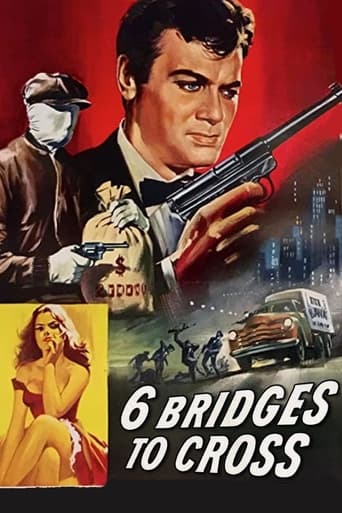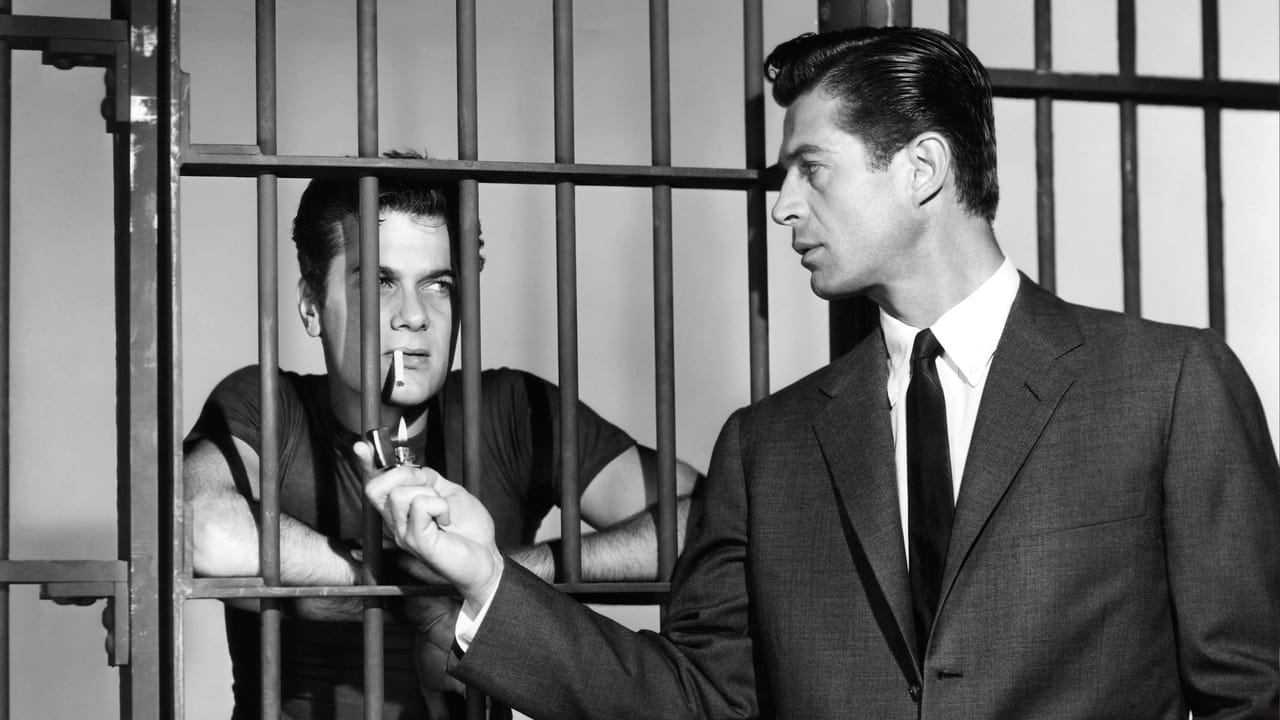calvinnme
This film is a crime drama that traces the strange relationship of a street smart hoodlum (Tony Curtis) with a straight arrow cop over 20 years. The film starts out with Sal Mineo playing adolescent hoodlum Jerry Florea in 1933, robbing street vendors of fruit with his gang and doing some nighttime breaking and entering. It is fleeing after one of these nighttime burglaries when Florea is shot by rookie cop Edward Gallagher (George Nader). Ed thought he shot an adult, and is upset when he realizes he shot a kid, plus due to his wound Jerry will never be able to have kids of his own. Being that this is during the production code era, that is as detailed as the wound description gets. The community is in an uproar over the shooting of a child, juvenile delinquent or not, but Gallagher manages to keep his job. Gallagher's guilt does cause him to strike up a friendship with Jerry that begins as Jerry is recovering in the hospital. Jerry gives Gallagher tips on crimes that help his career, and Ed tries to befriend the boy and point him in the right direction, only to be let down time and again. Both Curtis and Mineo were great in this. They really do seem to be playing the exact same character at different ages. As adult Jerry Florea, Curtis flashes that charming smile of his and plays the lying sociopath so well that even an audience should have a hard time determining when he is conscientious and when he is not. Florea can be violent when he needs to be, but mainly thieving and its thrill are his game. He doesn't even seem to enjoy the actual fruit of his theft that much. An interesting piece of trivia - Sammy Davis Jr. sings the film's theme song. It was in route to the recording studio to sing this song that he had the car accident that caused him to lose an eye.
JohnHowardReid
Six Bridges to Cross is supposed to be based on the famous Brinks Payroll robbery but bears hardly the slightest resemblance to that celebrated case (for one thing the police still don't have a clue as to who the criminals were and they are still at large) which was obviously used purely as a publicity gimmick to sucker the unwary into seeing what is essentially a very, very familiar gangster yarn - in fact it is probably the oldest chestnut in the business and has been used before in scores and scores of much more worthy films than this pretentious little bit of hoke.For all the touting in the Foreword about filming in Boston, there is very little of Boston that gets onto the screen and what there is is so ordinary and un-unique the film might as well have been lensed in downtown Los Angeles.Admittedly, Pevney's direction in the street sequences with Sal Mineo is a shade more inventive than his usual humble standard and the photography has an attractive sheen, but once Curtis comes in, almost everything goes back to so-so!Mind you, there's a bit of routine action excitement, but there's also lots of talk with the stars jadedly going through their usual paces, Nader with furrowed brow, Curtis with winning smile, Jay C. Flippen laying down the law. Julie Adams has so small a part it's impossible to judge, yet the excellent girls playing Maggie the Screwball and Virginia Stewart don't figure in the end credits at all!Production values are very moderate. Pace is fair, but action climax is not much and film is lucky to get 6 out of 10.
Robert J. Maxwell
"Six Bridges To Cross" is not only the title but the lush theme song sung by Sammy Davis, Jr. "Six bridges to cross; which one is the right one?; I open my heart and I pray; six bridges to cross; let me cross the bridge that leads to you"... (insert sound of snoring).The six bridges are those that link the city of Boston with the surrounding area. One of them unquestionably leads to L'Espalier but all of them lead somewhere. It's 1933 in Boston, in the depths of the Great Depression, and the road taken by gang leader Sal Mineo and his half-dozen hoods leads to mischief, burglary, flirting with girls, smoking, and a bullet in the Mineo's family jewels. Mineo is a forgiving kid, though, and the officer who shot him, George Nader, feels a bit guilty and visits Mineo in the hospital. They chat comfortably.It's clear from the beginning that the production was handled a little carelessly. Sal Mineo and Tony Curtis were at the height of their popularity but all of the kids, and the adults too, wear the ducktail haircuts of the 1950s or otherwise betray the time frame. I've never understood why more attention wasn't paid to wardrobe and dialog in stories set in the past. By the time the story reaches the war years, the women's wardrobe is straight out of 1955. It doesn't take that much effort, and to ignore the demands of historical reality is not just an offense to the viewer but a constant reminder that what he's watching is only a movie. I mean, for instance, when Nader chides Mineo for stealing and Mineo replies, "Don't knock it," doesn't it occur to the writers that the phrase is anachronistic. Haven't they watched any movies made in 1936?I've always rather liked George Nader. His performances are unspectacular but reliable, and he's always on the side of the angels. Alas, he's been given a hair style that makes him resemble Dick Tracy's nemesis Flat Top. I could never understand Sal Mineo's popularity. I tend to squirm with embarrassment when he's on screen. Nader's wife is played by Julie Adams. Her features are oddly arranged but the gestalt is very appealing. She was unforgettable in a white bathing suit in "The Creature From the Black Lagoon." The Gill Man kidnapped her and carried her to his lair. I always wondered what was going through his mind. I have the same problem with King Kong and Fay Wray. Part of the film was shot on location in Boston and environs. It's not easy to shoot a period film in a modern city, so what we see of Boston is limited to rooftops and other settings that don't reflect the mid-century.Anyway a few years pass and Mineo has grown up into Tony Curtis, who was at his handsomest, cockiest, and most winning. He rarely stops grinning but when he does he handles the scene well. It began to remind me a bit of Paul Newman's "Somebody Up There Likes Me," except that Newman's Pythias had no Damon. Nader gets out of the Army and Curtis gets out of the slams. Both succeed in their work -- Nader becomes a lieutenant of detectives and Curtis becomes a rich racketeer -- but the relationship continues, not really friendly anymore, but business-like, with Curtis snitching only when it's to his benefit. No change in personalities though. Nader remains the bland conformist and Curtis the glib and cheeky ex delinquent. I couldn't help noticing how much Curtis's talents had developed between this film, in 1955, and "The Boston Strangler" in 1968. Here, he's just okay. As the strangler he was superb, and even used a convincing regional accent.To everyone's surprise, Curtis decides to straighten up and fly right. He even convinces Nader. He ditches his rackets and opens a string of gas stations, spends most of his "cabbage" to get a pardon, and marries the widow of an old friend. Curtis' wife brings nothing to the party but her acting-class delivery might just reflect the movie's pedestrian direction. At this point, a priest and three young kids enter the plot. The priest is okay, as movie priests go, but the cute little kids are revolting. Then a multi-million dollar heist is pulled off in a style similar to Curtis'. True, Curtis and his new wife were having dinner at Nader's house at the time of the robbery, but the crime has his signature. The Feds find a reason to deport Curtis, an immigrant's son and a non-citizen, and this leads to a climactic shoot out.It's not a stupid movie by any means and the plot has real potential -- a law enforcement officer and his snitch become friends. It was neatly handled in "Report to the Commissioner." It's hampered here by direction that's almost mechanical in nature and by a couple of unimpressive performances. It's too bad because a lot of promise was wasted.
aromatic-2
Tony Curtis gives one of the best performances of his career as the mastermind of an armoured car robbery. This movie avoids cliches and goes straight to original character development while paying meticulous detail to the orchestration of the caper. Thoroughly absorbing from every standpoint.


 AD
AD


